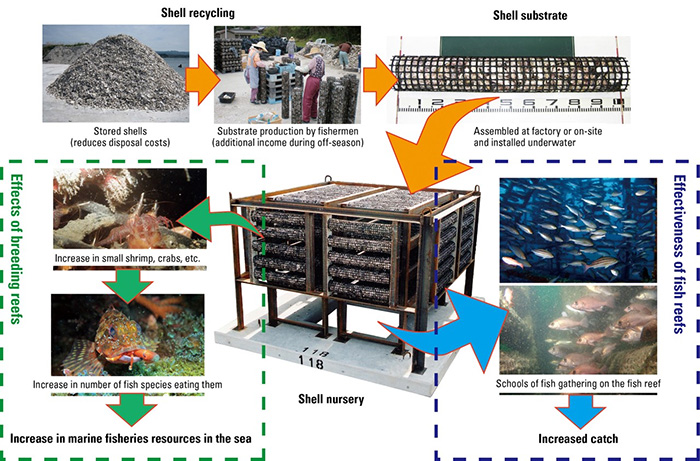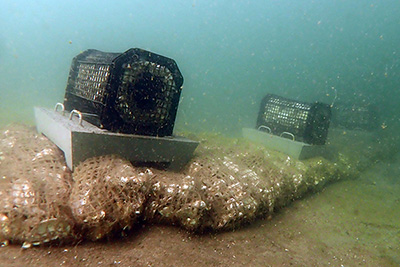Ocean Newsletter
No.515 January 20, 2022
-
The Current Situation and Outlook of Aquaculture within Japan and Abroad
HAGIWARA Atsushi
Professor, Graduate School of Fisheries and Environmental Sciences, Nagasaki UniversityAs the world population grows and economies develop, the demand for food is projected to increase. At the same time, however, the planet’s health cannot be compromised in response to this situation. In order to continue supplying mankind with nutritious food, there are high expectations for aquaculture. On the other hand, in Japan, aquaculture is gaining attention as a way to promote regional development where the population has begun to decline and rural depopulation is rising. This article examines this bipolarized situation. -
Creating Sustainable Fishing Environment Through Seashell Technology
KATAYAMA Masaki
President, Ocean Construction Co. Ltd.Seashells are natural materials with calcium carbonate as their principal component which do not contain any harmful substances. Under the principle of “making use of seashells for the sea,” we have developed and been spreading technology utilizing seashells. This technology also contributes greatly to sustainable fisheries, aligning with Goal 14 of the SDGs, to “conserve and sustainably use the oceans.” Ocean Construction has started new initiatives accordingly. -
Hemp Merchants who Linked the Seas of Kujukuri and Tochigi Prefecture
KASHIWAMURA Yuji
Honorary Curator, Tochigi Prefectural MuseumI would like to introduce the activities of hemp merchants in the Edo Period who linked the hemp fields of Tochigi Prefecture, located far from the ocean, and the seas off Kujukuri Beach. Hemp merchants sold Tochigi Prefecture’s yashuu-asa (yashuu-hemp) to the fishing boat owners of Kujukuri Beach, who required vast amounts of hemp for fishing nets. On their return trip, the merchants brought back sardines that had been hung and dried in order to use as fertilizer. The shrewd assessment of a situation in which boat owners wished to sell large amounts of dried sardines, and the Kanuma region’s hemp farmers’ need for dried sardines as fertilizer, is believed to have led to production which benefited both groups.
Creating Sustainable Fishing Environment Through Seashell Technology
[KEYWORDS] fisheries environment / seashell recycling / enriching the seaKATAYAMA Masaki
President, Ocean Construction Co. Ltd.
Seashells are natural materials with calcium carbonate as their principal component which do not contain any harmful substances. Under the principle of “making use of seashells for the sea,” we have developed and been spreading technology utilizing seashells. This technology also contributes greatly to sustainable fisheries, aligning with Goal 14 of the SDGs, to “conserve and sustainably use the oceans.” Ocean Construction has started new initiatives accordingly.
What are Shell Utilization Technologies?
Shells are produced by shellfish to protect themselves as they grow. They are a biomineral composed mainly of calcium carbonate. Since ancient times, they have been used as ornaments, as daily necessities, and as coins. Their constituents have also been used in cosmetics, fertilizers, and medicines. In this way, shells have a wide variety of uses. Due to their shape and the fact that they are a natural material produced in the sea, we use them for nurturing fish, shellfish and other sea creatures based on our motto, “utilizing shells in the sea where they were born.”
One example is JF Shell Nurse, an artificial fish reef made of seashells. Shell nurseries are primarily made of shells generated by oyster, scallop, and pearl farming. Shell substrate, a mesh-like tube (mesh size of 2 to 3 cm) filled with shells, is incorporated into steel and assembled into panel-shaped parts. This construction allows the substrate to be shaped and sized to suit the depth of water in target areas or fish varieties being supported. Shell substrate is filled with intricately shaped shells. Tiny shrimp, crabs, and lugworms become established in the gaps between them, increasing in number and becoming food for the small fish that eat them. Larger fish that feed on these smaller fish then begin to gather, creating a new ecosystem around the fish reef. The substrate thus increases the number of fish and shellfish that can be fished or caught by gillnetting, also causing a positive effect on biodiversity. These effects have been proven through demonstrations conducted since development began along the coast of Kurashiki City, Okayama Prefecture. Sample boat surveys have also been conducted with the cooperation of fishermen in Hirado City, Nagasaki Prefecture, and diving and gillnetting surveys have been performed along the coast of Mihara City, Hiroshima Prefecture. These results have also been actively published in academic journals and discussed at academic conferences on fisheries and oceanography. The shell substrate is produced by fishermen engaged in shellfish aquaculture during the relatively quiet spring and summer months, allowing them to earn a little extra income while contributing to efforts to enrich the sea. The introduction of shell nurseries thus has several layers of overlapping benefits for all involved.
Along with the above, other fishing ground development projects are being conducted throughout Japan by laying oyster, scallop, blood clam, and other shells on the seafloor according to the conditions in the area. Each has been shown to improve the environment and increase fish catches.
Development and Dissemination of the Shell Utilization Technologies
The technologies that utilize shells were initially conceived by our founder, Keiichi Katayama, who was originally a fisherman and experienced firsthand the rapid changes in local areas of the Seto Inland Sea due to development linked to high economic growth. His fellow fishermen knew that bait worms (lugworms and shellfish like shrimps and crabs that act as feed for fish) occur in abundance on the seafloor in areas where oyster shells have been deposited. At the time, fishing cooperatives throughout Japan were also facing issues of disposing oyster shells produced after shucking and shipping. The connection between these issues led Katayama to the idea that shells could be used as a valuable material in artificial fish reefs. Since around 1985, we have been working with researchers in Okayama Prefecture to develop shell nurseries. This concept was first practically implemented in 1994 and has since been widely used in fisheries-related public projects nationwide. Ongoing effectiveness studies (visual observations through diving and prey animal culture tests using test pieces, etc.) conducted since their initial development have shown that these nurseries have been used by approximately 380 species of fish and shellfish to date, while more than 660 species have been confirmed to live in the shell test pieces.
We have also been developing smaller blocks of shells that are easier to use for small-scale initiatives that are not big enough to be public works projects. We are also working on technologies to utilize shells by laying them on the seafloor, which is becoming increasingly popular at fishing ports and harbors in various regions. In 2018, in cooperation with the Japan International Cooperation Agency (JICA), we also conducted a demonstration test of a small-scale shell-based fish reef using local shells in the waters near La Paz in the Gulf of California, Mexico. The results showed remarkable effects on the ecosystem's productivity.
 ■Figure 1: Characteristics and Roles of JF Shell Nurses
■Figure 1: Characteristics and Roles of JF Shell Nurses
Toward the development of sustainable fisheries
While global fisheries production and consumption of marine products have been on a remarkable upward trend led by China, fishing vessel-based production on the sea surface has been at a standstill since the 1990s. Since the deep-sea fishing industry's peak, production in Japan's fisheries has also declined sharply up to the 200 nautical miles. Recently, poor catches of saury, Japanese flying squid, and salmon have been making headlines every year. Resource management based on scientific evidence and habitat improvement in coastal areas is vital for sustaining fisheries production under these circumstances. Offshore wind power generation is also attracting attention as a primary strategy for building a carbon-neutral society by 2050. Offshore wind power generation facilities are often planned in waters with good fishing grounds, and the combination of these factors is also an important unifying theme. Technologies for utilizing shells can contribute to the improvement of coastal habitats. At the same time, when combined with offshore wind power generation facilities, which are expected to develop further going forward, they can also contribute to the maintenance and improvement of fishing grounds and biological habitats. In addition, we aim to promote initiatives to conserve and create biological habitats, such as the use of small, underutilized fishing ports for increased aquaculture and nature-symbiotic fishing ports and harbor facilities.
One specific example currently underway is an initiative to convert fishing ports into biotopes (habitats for living organisms). Since the initial development of the shell nurseries, we have had a close relationship with Shiraishi Island, a remote island in Kasaoka City, Okayama Prefecture. A study is now underway to test the effectiveness of small shell blocks containing octopus pots, along with mats of shells stuffed into nets made of natural materials in a new fishing port on the eastern part of the island (Figure 2). We aim to increase biological productivity in fishing ports by applying technologies that utilize shells in the mounds of breakwaters and the toe of the slope. This study is being conducted at quiet fishing port facilities that are valuable habitats for aquatic organisms, especially for juvenile fish and as spawning grounds. A biological survey in fiscal 2020 confirmed that a variety of sea life was using the area, finding common octopus eggs, marbled rockfish, dark-banded rockfish, and sea cucumbers. The idea is to create a fishing port version of a biotope, which could eventually be used as a venue for educational activities on sustainable fishing, in conjunction with environmental education and leisure activities. (End)
 ■Fig. 2 Small Shell Blocks and Shell Mats
■Fig. 2 Small Shell Blocks and Shell Mats
